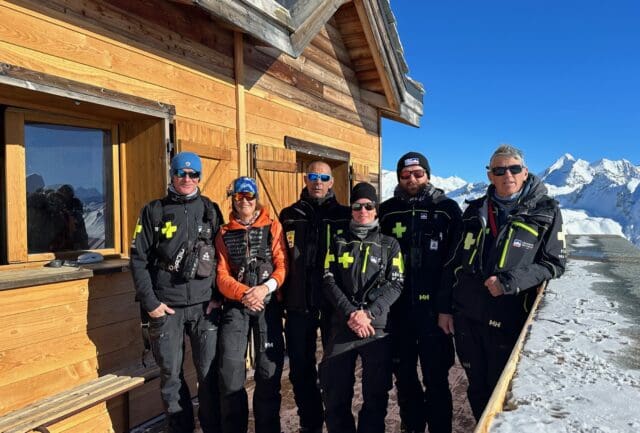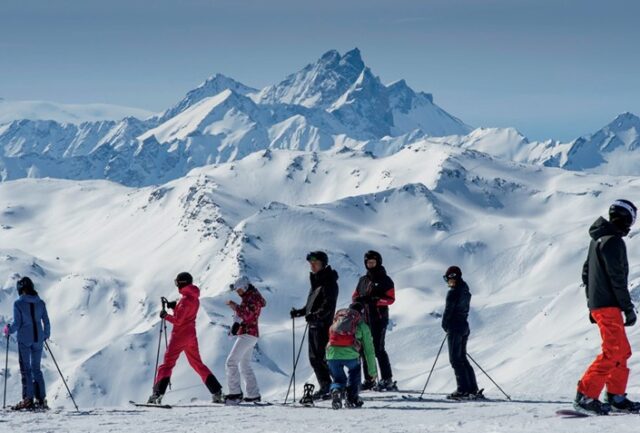The Hofer family – on a quest to find the best Christmas skiing experience for families with children – explore the ‘wet field’, a steep mountain pass between Austria and Italy, and find a kids’ paradise in the Gartnerkofel Hotel
WORDS: ANDREAS HOFER
GOOD VALUE, GREAT SKIING
Feeling peckish? Meals at Gartnerkofer are reason to visit alone. Full board included breakfast, lunch (easy to reach, as the hotel is in the middle of the ski area), high tea with sweets and cakes and, without exception, sumptuous dinners. They always included vegetarian choices of Michelin-rated quality. The fish display on Fridays was a 10m-long extravaganza with whole sharks and a giant moon fish reigning over a cornucopia from the Mediterranean Sea, only a short drive away. The wine list offered Austria’s and Italy’s best, at affordable prices.
The lift passes are printed in the hotel. The skis and boots are rented in the hotel. The ski school is in the hotel. The spa is the only detriment, really. It is so luxurious that only the most passionate skier can be persuaded to hit the slopes.
Sadly, the kids too are lured indoors. The play area is spread over five floors, with chutes connecting the activity areas. Child minders are taking care of one’s offspring from morning to the evening. Films are played. A fully supervised, five- storey climbing wall passes air castles, trampoline fields and handicraft schools. It was sheer luck that little Minna had such an adorable, patient ski instructor. After years of at times fierce resistance, she caught the bug. He moulded her into a ski afficionado. At the end of our stay, she was skiing long verticals at frightening speed, fully controlling her turns, while shouting with joy: “Let’s go faster, guys!”
The Nassfeld ski circuit offers 110km of ski pistes, with a good mix of blue, red and black runs, while 30 cable cars and chairlifts transport skiers without gruesome waiting times. Its top stations Rudniksattel (1,950m), Kofelplatz (1,919m) and Garnitzer Alm (1,649m) are surrounded by spectacular Dolomite rock, offering views to the snow-capped peaks of the main Alps on the other side of the Gailtal Valley. The longest run, from Troghoehe (2,020m) to the Troepolach station (610m) is a smooth ride over almost 1,600 vertical meters. They don’t have anything like that in Heiligenblut!
POWDER GALORE
It turned out that I had completely misunderstood the true meaning of ‘wet field.’ As this Dolomite border range with Italy is the first hurdle for all moisture coming in from the Mediterranean Sea, it is unusually snow-prone. The local tourist board claims an average snowfall of 7-8m per season. In times of climate change, I would take this with a pinch of salt. Two local mountain guides who I contacted a few weeks prior to our arrival pompously declined: “I don’t want to ruin my skis,” said the first, while the second went in search for snow to Italy. I was in a bind. Piste skiing is not my thing, really. I don’t enjoy carpeted, groomed pistes as much as little Minna does.
I therefore called up my trusted guide in the Dolomites, Kurt Walde in Brunegg. His town in the Puster Valley is connected to the Gailtal Valley (where Nassfeld is located) by the remote, hard-to-reach Lesachtal Valley. It has no ski resorts to boast of. Cold and snow-safe, it is a Nordic skiing paradise. Endless tracks connect wildly romantic villages from west to east with the spectacular Maria Luggau monastery as its cultural centre. Halfway between Hermagor/Nassfeld and Brunico/Brunegg, it would take him about the same time as me to meet up for daily ski tours to the southern peaks of the border mountains to Italy. It would be about an hour’s drive for each of us. He was as a happy as I was to meet up again after a too-long summer and autumn. His plan was to explore the north-facing side valleys of Lesachtal.
“We always find snow, don’t we?” he said with a laugh, and that was that. Every evening he would send me the coordinates of the starting points for the following day: Leiten, Kartitsch, Rauchenbach – villages built from greying logs and roofed with shingles, each sporting a quaint baroque church in the middle. For 10 days we scaled a different peak every day – jagged summits like Wildkaregg (2,532m), Ofenspitze (2,334m), Hollbrucker Spitze (2,580m), Schoentalhoehe (2,535m), and the Grosser Kinigat (2689m). Each tour started at the edge of dense forests. Only after 500 to 600m altitude we would reach open terrain. We passed the boarded-up huts of trans-humane shepherds and the lone log-houses of hunters steeped in snow.
There was no human soul around. Only the tracks of snow hares, deer and, higher up, of chamois. At the end of only mildly strenuous hikes – we covered in average not more than 1,300m altitude each day – we would huddle under the summit cross bathed in sunshine and munch our butties. In front of us the mighty peaks of the Dolomites: Tofana, Drei Zinnen, Langkofel, mighty reminders of adventures past.
Turning north was the irresistible beckoning of sun-bereft slopes, steeped in pristine, virgin powder. No risk to our skis indeed. After New Year we hugged each other goodbye, promising to return in spring. There were only few days left until the end of our Christmas vacations and I wanted to hang out with my family. I was looking forward to skiing with little Minna and cheering her in the ski school race. So many cosy ski huts to try out, so many tales to tell of Lesachtal and its enchanted villages…
But then wet field became powder galore. Within a single night a metre of fresh snow smothered the resort. All my good intentions as a family man came to nought. As long as the ski lifts were running I set my tracks in fresh powder, followed by my three grown up daughters, who all of a sudden had forgotten about family too. ❚








